Title 30
SECTION 100.3
100.3 Determination of penalty amount; regular assessment.
§ 100.3 Determination of penalty amount; regular assessment.(a) General. (1) Except as provided in § 100.5(e), the operator of any mine in which a violation occurs of a mandatory health or safety standard or who violates any other provision of the Mine Act, as amended, shall be assessed a civil penalty of not more than $74,775. Each occurrence of a violation of a mandatory safety or health standard may constitute a separate offense. The amount of the proposed civil penalty shall be based on the criteria set forth in sections 105(b) and 110(i) of the Mine Act. These criteria are:
(i) The appropriateness of the penalty to the size of the business of the operator charged;
(ii) The operator's history of previous violations;
(iii) Whether the operator was negligent;
(iv) The gravity of the violation;
(v) The demonstrated good faith of the operator charged in attempting to achieve rapid compliance after notification of a violation; and
(vi) The effect of the penalty on the operator's ability to continue in business.
(2) A regular assessment is determined by first assigning the appropriate number of penalty points to the violation by using the appropriate criteria and tables set forth in this section. The total number of penalty points will then be converted into a dollar amount under the penalty conversion table in paragraph (g) of this section. The penalty amount will be adjusted for demonstrated good faith in accordance with paragraph (f) of this section.
(b) The appropriateness of the penalty to the size of the business of the operator charged. The appropriateness of the penalty to the size of the mine operator's business is calculated by using both the size of the mine cited and the size of the mine's controlling entity. The size of coal mines and their controlling entities is measured by coal production. The size of metal and nonmetal mines and their controlling entities is measured by hours worked. The size of independent contractors is measured by the total hours worked at all mines. Penalty points for size are assigned based on Tables I to V. As used in these tables, the terms “annual tonnage” and “annual hours worked” mean coal produced and hours worked in the previous calendar year. In cases where a full year of data is not available, the coal produced or hours worked is prorated to an annual basis. This criterion accounts for a maximum of 25 penalty points.

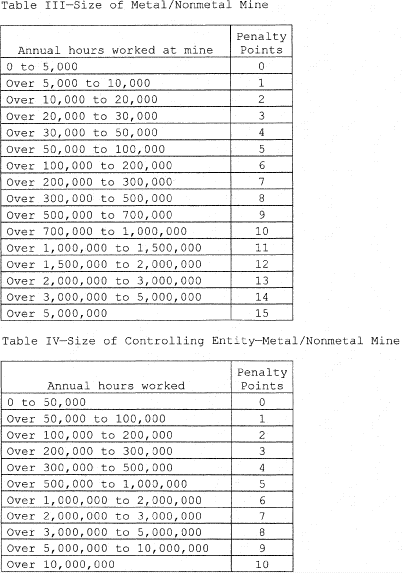
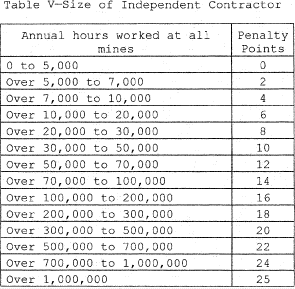
(c) History of previous violations. An operator's history of previous violations is based on both the total number of violations and the number of repeat violations of the same citable provision of a standard in a preceding 15-month period. Only assessed violations that have been paid or finally adjudicated, or have become final orders of the Commission will be included in determining an operator's history. The repeat aspect of the history criterion in paragraph (c)(2) of this section applies only after an operator has received 10 violations or an independent contractor operator has received 6 violations.
(1) Total number of violations. For mine operators, penalty points are assigned on the basis of the number of violations per inspection day (VPID)(Table VI). Penalty points are not assigned for mines with fewer than 10 violations in the specified history period. For independent contractors, penalty points are assigned on the basis of the total number of violations at all mines (Table VII). This aspect of the history criterion accounts for a maximum of 25 penalty points.
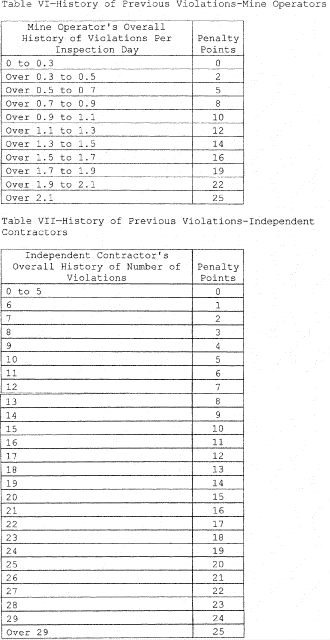
(2) Repeat violations of the same standard. Repeat violation history is based on the number of violations of the same citable provision of a standard in a preceding 15-month period. For coal and metal and nonmetal mine operators with a minimum of six repeat violations, penalty points are assigned on the basis of the number of repeat violations per inspection day (RPID) (Table VIII). For independent contractors, penalty points are assigned on the basis of the number of violations at all mines (Table IX). This aspect of the history criterion accounts for a maximum of 20 penalty points (Table VIII).

(d) Negligence. Negligence is conduct, either by commission or omission, which falls below a standard of care established under the Mine Act to protect miners against the risks of harm. Under the Mine Act, an operator is held to a high standard of care. A mine operator is required to be on the alert for conditions and practices in the mine that affect the safety or health of miners and to take steps necessary to correct or prevent hazardous conditions or practices. The failure to exercise a high standard of care constitutes negligence. The negligence criterion assigns penalty points based on the degree to which the operator failed to exercise a high standard of care. When applying this criterion, MSHA considers mitigating circumstances which may include, but are not limited to, actions taken by the operator to prevent or correct hazardous conditions or practices. This criterion accounts for a maximum of 50 penalty points, based on conduct evaluated according to Table X.

(e) Gravity. Gravity is an evaluation of the seriousness of the violation. This criterion accounts for a maximum of 88 penalty points, as derived from the Tables XI through XIII. Gravity is determined by the likelihood of the occurrence of the event against which a standard is directed; the severity of the illness or injury if the event has occurred or was to occur; and the number of persons potentially affected if the event has occurred or were to occur.
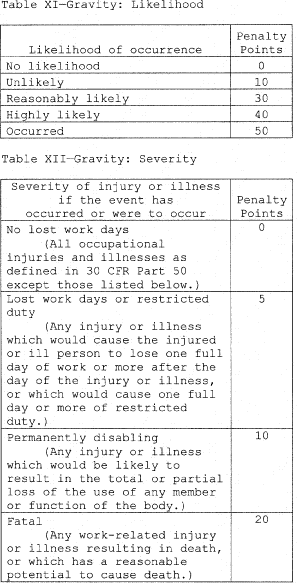
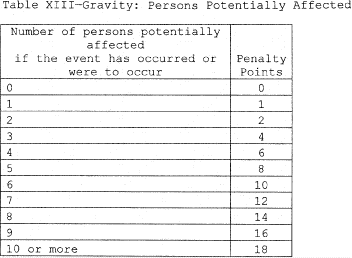
(f) Demonstrated good faith of the operator in abating the violation. This criterion provides a 10% reduction in the penalty amount of a regular assessment where the operator abates the violation within the time set by the inspector.
(g) Penalty conversion table. The penalty conversion table is used to convert the total penalty points to a dollar amount.
Table XIV - Penalty Conversion Table
| Points | Penalty ($) |
|---|---|
| 60 or fewer | $139 |
| 61 | 152 |
| 62 | 163 |
| 63 | 177 |
| 64 | 192 |
| 65 | 208 |
| 66 | 225 |
| 67 | 245 |
| 68 | 264 |
| 69 | 286 |
| 70 | 310 |
| 71 | 336 |
| 72 | 365 |
| 73 | 395 |
| 74 | 426 |
| 75 | 463 |
| 76 | 504 |
| 77 | 542 |
| 78 | 589 |
| 79 | 638 |
| 80 | 692 |
| 81 | 749 |
| 82 | 810 |
| 83 | 879 |
| 84 | 952 |
| 85 | 1,033 |
| 86 | 1,118 |
| 87 | 1,210 |
| 88 | 1,311 |
| 89 | 1,421 |
| 90 | 1,539 |
| 91 | 1,667 |
| 92 | 1,805 |
| 93 | 1,955 |
| 94 | 2,119 |
| 95 | 2,295 |
| 96 | 2,486 |
| 97 | 2,692 |
| 98 | 2,918 |
| 99 | 3,161 |
| 100 | 3,425 |
| 101 | 3,709 |
| 102 | 4,018 |
| 103 | 4,353 |
| 104 | 4,715 |
| 105 | 5,109 |
| 106 | 5,534 |
| 107 | 5,995 |
| 108 | 6,494 |
| 109 | 7,035 |
| 110 | 7,621 |
| 111 | 8,253 |
| 112 | 8,943 |
| 113 | 9,688 |
| 114 | 10,496 |
| 115 | 11,369 |
| 116 | 12,315 |
| 117 | 13,342 |
| 118 | 14,453 |
| 119 | 15,657 |
| 120 | 16,960 |
| 121 | 18,374 |
| 122 | 19,902 |
| 123 | 21,561 |
| 124 | 23,358 |
| 125 | 25,300 |
| 126 | 27,409 |
| 127 | 29,693 |
| 128 | 32,165 |
| 129 | 34,844 |
| 130 | 37,747 |
| 131 | 40,891 |
| 132 | 44,295 |
| 133 | 47,984 |
| 134 | 51,812 |
| 135 | 55,638 |
| 136 | 59,468 |
| 137 | 63,292 |
| 138 | 67,121 |
| 139 | 70,947 |
| 140 or more | 74,775 |
(h) The effect of the penalty on the operator's ability to continue in business. MSHA presumes that the operator's ability to continue in business will not be affected by the assessment of a civil penalty. The operator may, however, submit information to the District Manager concerning the financial status of the business. If the information provided by the operator indicates that the penalty will adversely affect the operator's ability to continue in business, the penalty may be reduced.
[72 FR 13635, Mar. 22, 2007, as amended at 73 FR 7209, Feb. 7, 2008; 81 FR 43455, July 1, 2016; 82 FR 5383, Jan. 18, 2017; 83 FR 14, Jan. 2, 2018; 84 FR 219, Jan. 23, 2019; 85 FR 2299, Jan. 15, 2020; 86 FR 2970, Jan. 14, 2021]